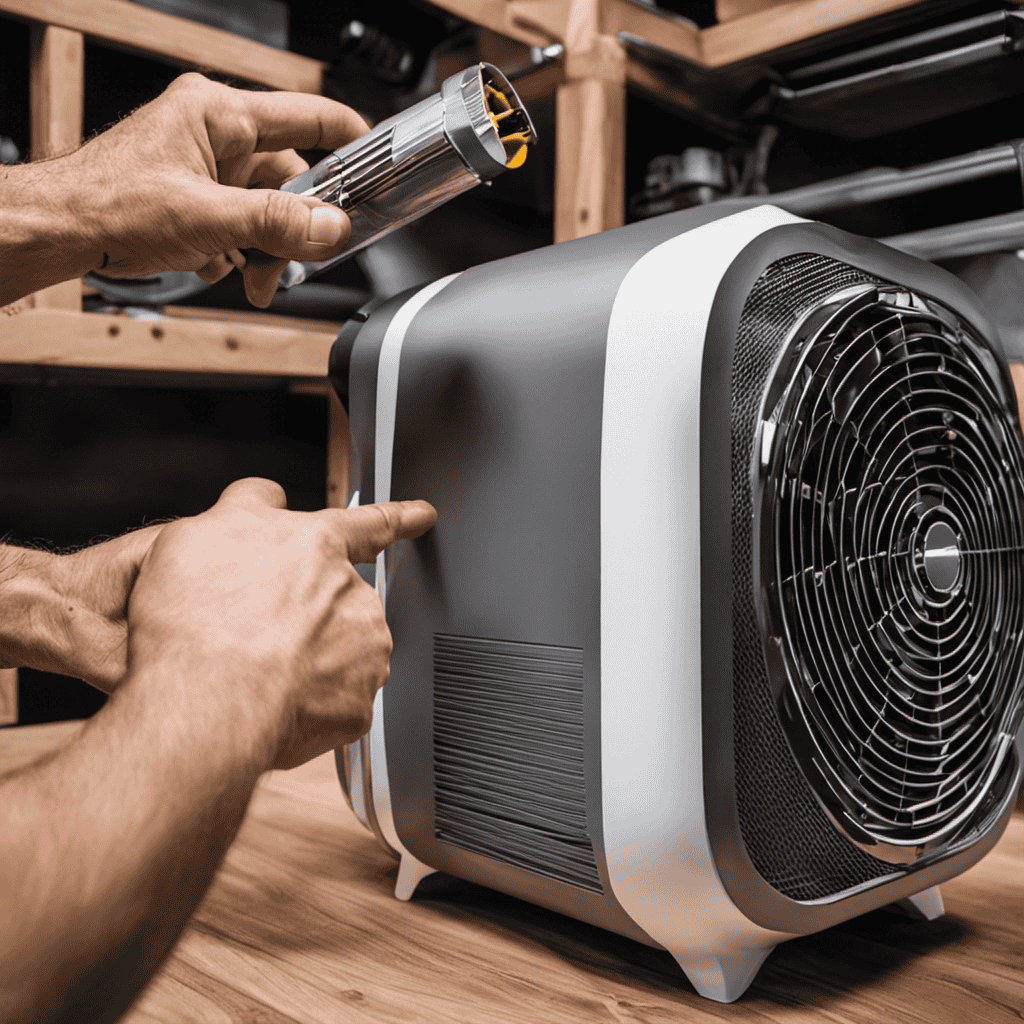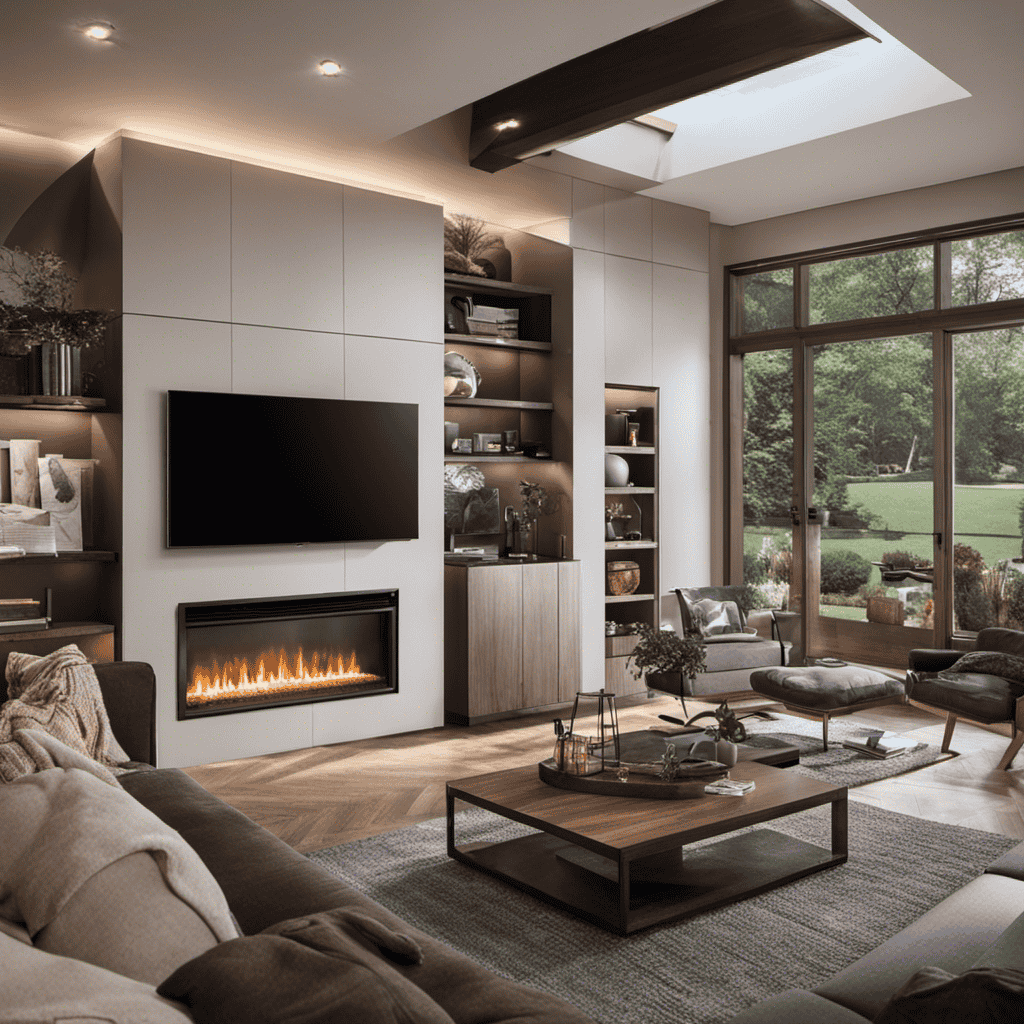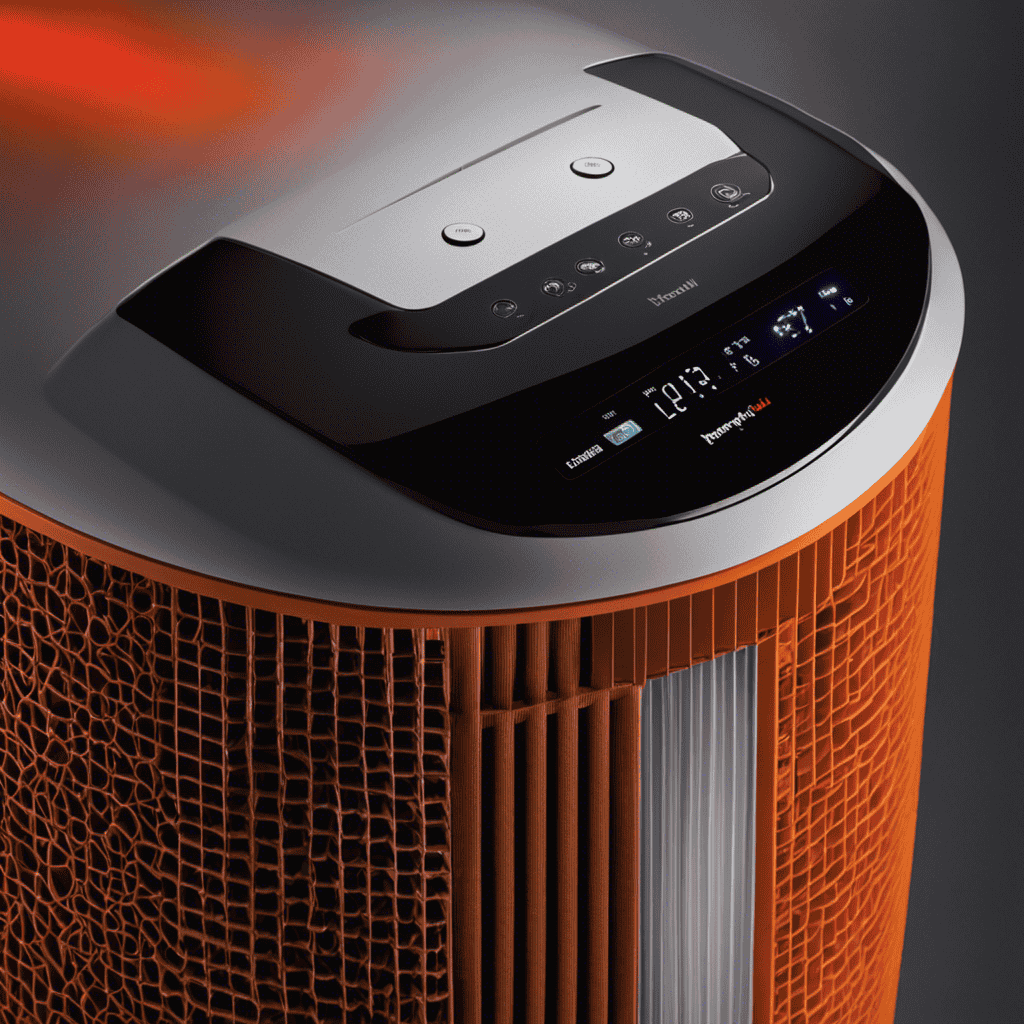I know what you’re thinking – do I really need an air purifier? Well, let me tell you, the quality of the air we breathe indoors can have a significant impact on our health.
From common pollutants like dust and pet dander to more harmful substances like mold spores and volatile organic compounds (VOCs), our indoor air can be filled with invisible threats.
In this article, I’ll guide you through the signs of poor indoor air quality and help you determine if an air purifier is the right solution for you.
Key Takeaways
- Poor indoor air quality can lead to respiratory issues and other illnesses.
- Lingering unpleasant odors can indicate the presence of pollutants.
- Symptoms like sneezing, coughing, watery eyes, and headaches may indicate the need for an air purifier.
- Using an air purifier can help eliminate odors and improve sleep quality.
Understanding Air Quality
To understand air quality, you should be aware of the different factors that can affect it. Air pollution sources play a significant role in determining the quality of the air we breathe. These sources can include industrial emissions, vehicle exhaust, and even natural pollutants like pollen and dust.
The presence of these pollutants in the air can have detrimental effects on our health, leading to respiratory issues and other illnesses. To measure the quality of the air, scientists use an air quality index (AQI). The AQI is a numerical value that indicates the level of pollution in the air and helps us understand the potential health risks associated with it.
Common Indoor Air Pollutants
Identify common indoor air pollutants that may impact your health and well-being.
Indoor air quality can have a significant impact on our health, as we spend a significant amount of time indoors. Common indoor air pollutants include dust, pollen, pet dander, mold spores, and volatile organic compounds (VOCs) from household products. These pollutants can cause a range of health issues, including allergies, asthma, respiratory infections, and even long-term health problems.
To improve indoor air quality, there are several solutions available. One effective solution is to use an air purifier, which can help remove these pollutants from the air. However, it is important to maintain the air purifier properly to ensure its effectiveness. Regular maintenance, such as cleaning or replacing filters, is crucial for optimal performance and to prevent the buildup of pollutants.
Signs of Poor Indoor Air Quality
When it comes to discussing signs of poor indoor air quality, it is crucial to consider the physical symptoms experienced by individuals. These symptoms can range from headaches and fatigue to dizziness and irritation of the eyes, nose, and throat.
Another important aspect to consider is the presence of lingering unpleasant odors, which can indicate the presence of pollutants in the air.
Lastly, poor indoor air quality can lead to increased respiratory issues, such as asthma and allergies, as the contaminants in the air can exacerbate these conditions.
Physical Symptoms Experienced
If you’re experiencing symptoms like sneezing or coughing, you may need an air purifier. Physical symptoms can be indicative of poor indoor air quality, which is often caused by air pollution. Here are some common physical symptoms that may suggest the need for an air purifier:
| Symptom | Description | Possible causes |
|---|---|---|
| Sneezing | Repeatedly expelling air from the nose and mouth due to irritation. | Allergens, dust, pet dander. |
| Coughing | A reflex action to clear the airways of mucus and irritants. | Pollutants, smoke, mold spores. |
| Watery eyes | Excessive tear production in response to irritation. | Allergens, pollutants. |
| Headaches | Pain or discomfort in the head. | Volatile organic compounds, toxic chemicals. |
If you experience any of these symptoms frequently, it may be worth considering an air purifier to improve the quality of the air you breathe. Remember to choose an air purifier that is suitable for your specific needs and addresses the pollutants that are causing your symptoms.
Lingering Unpleasant Odors
To effectively eliminate lingering unpleasant odors, consider using an air purifier that specifically targets and removes odor-causing particles from the air you breathe. An air purifier can help improve indoor air quality by eliminating allergens and other pollutants that contribute to unpleasant odors.
Here are four ways an air purifier can help eliminate odors and improve your sleep quality:
-
Capturing and neutralizing odor-causing particles, such as pet dander and smoke, through advanced filtration technology.
-
Releasing clean, fresh air back into the room, helping to create a more pleasant and odor-free environment.
-
Reducing the presence of airborne bacteria and viruses that can contribute to unpleasant odors.
-
Improving overall air circulation, preventing stagnant air and reducing the buildup of odors in your living space.
Increased Respiratory Issues
To improve your respiratory health, consider investing in an air purifier that specifically targets and removes airborne pollutants. Increased allergies and respiratory diseases are becoming more common due to the rise in air pollution and the presence of allergens in our environment. An air purifier can help alleviate these issues by filtering out harmful particles such as dust, pollen, pet dander, and mold spores.
Here is a table that illustrates the potential benefits of using an air purifier:
| Air Purifier Benefits | |
|---|---|
| Reduces allergens | |
| Cleanses the air | |
| Removes pollutants | |
| Filters out dust | |
| Eliminates odors |
Investing in an air purifier is a proactive step towards improving your respiratory health and reducing the symptoms associated with increased allergies and respiratory diseases. Don’t let poor air quality hinder your well-being; prioritize clean air with the help of an air purifier.
Health Effects of Poor Air Quality
As I delve into the discussion on the health effects of poor air quality, two key points that merit exploration are the symptoms of air pollution and the long-term health risks associated with it.
When it comes to symptoms, individuals may experience a range of respiratory issues such as coughing, wheezing, and shortness of breath.
However, the long-term health risks are even more concerning, as exposure to air pollution has been linked to chronic conditions like heart disease, lung cancer, and even premature death.
Symptoms of Air Pollution
Are you experiencing symptoms like coughing, sneezing, or itchy eyes? These could be signs that you are being affected by air pollution. Air pollution is caused by various factors such as vehicle emissions, industrial activities, and burning of fossil fuels.
When we breathe in polluted air, it can have detrimental effects on our health, especially for children. Here are four common symptoms of air pollution:
-
Persistent coughing: This could be a result of the irritation caused by pollutants in the air.
-
Sneezing and nasal congestion: Pollutants can irritate the nasal passages, leading to frequent sneezing and congestion.
-
Itchy or watery eyes: Air pollution can cause inflammation and irritation in the eyes, resulting in itchiness and excessive tearing.
-
Respiratory problems: Prolonged exposure to polluted air can lead to respiratory issues such as asthma, bronchitis, and even lung cancer.
It is important to be aware of these symptoms and take necessary measures to protect ourselves and our children from the harmful effects of air pollution.
Long-Term Health Risks
Have you considered the potential long-term health risks associated with prolonged exposure to air pollution?
It is important to understand the long-term effects of air pollution on our health and the potential health implications it may have.
Studies have shown that prolonged exposure to air pollution can lead to a range of health problems, including respiratory diseases such as asthma and chronic obstructive pulmonary disease (COPD).
Additionally, air pollution has been linked to cardiovascular diseases, such as heart attacks and strokes.
The harmful particles present in polluted air can also penetrate deep into the lungs and enter the bloodstream, causing inflammation and damage to various organs.
Moreover, long-term exposure to air pollution has been associated with an increased risk of developing lung cancer.
Therefore, it is crucial to take measures to reduce air pollution and protect our long-term health.
Factors to Consider Before Buying an Air Purifier
Before buying an air purifier, there are a few factors you should consider.
-
Air Purifier Effectiveness: Look for an air purifier that is capable of removing a wide range of pollutants from the air, such as dust, pollen, pet dander, and mold spores. Check the Clean Air Delivery Rate (CADR) to determine how efficiently it can clean the air in your space.
-
Cost of Air Purifiers: Consider your budget and the long-term costs associated with owning an air purifier. Take into account the initial purchase price, as well as the cost of replacement filters and energy consumption. Remember that higher-priced models may offer better performance and durability.
-
Room Size: Determine the size of the room where you plan to use the air purifier. Different models have varying coverage areas, so make sure to choose one that is suitable for the size of your space.
-
Noise Level: Consider the noise level of the air purifier, especially if you plan to use it in a bedroom or office. Look for models that have a noise level rating that won’t disturb your sleep or concentration.
Benefits of Using an Air Purifier
Using an air purifier can help improve indoor air quality, reducing the presence of pollutants such as dust, pollen, and pet dander. Not only does this benefit our respiratory health, but it also creates a more comfortable living environment. Air purifiers are especially beneficial for those with allergies or asthma, as they can alleviate symptoms and provide relief. Additionally, air purifiers can help eliminate odors and harmful chemicals, making the air we breathe cleaner and safer. To ensure optimal performance, regular air purifier maintenance is essential. This includes cleaning or replacing filters, checking for any malfunctions, and keeping the unit in a well-ventilated area. When considering cost-effective air purifiers, it is important to evaluate the initial purchase price, as well as the long-term cost of replacement filters and energy consumption.
| Pros | Cons |
|---|---|
| Improves indoor air quality | Initial purchase price |
| Reduces presence of pollutants | Cost of replacement filters |
| Alleviates allergies and asthma symptoms | Energy consumption |
| Eliminates odors and harmful chemicals | |
| Creates a comfortable living environment |
How to Choose the Right Air Purifier for Your Needs
When selecting the right air purifier for your needs, it’s important to consider factors such as room size, specific air quality concerns, and the type of filtration system that would be most effective.
-
Room size: Take measurements of the room you plan to use the air purifier in. This will help you determine the appropriate size and capacity needed to effectively clean the air.
-
Air quality concerns: Identify the specific pollutants or allergens you want to address. Different air purifiers are designed to target different contaminants, such as dust, pet dander, pollen, or smoke.
-
Filtration system: Research the different types of filtration systems available, such as HEPA filters, activated carbon filters, or UV light filters. Understand how each system works and which one would be most suitable for your specific needs.
-
Maintenance and cost: Consider the long-term maintenance requirements and costs associated with the air purifier. Some models require regular filter replacements, which can add to the overall cost of ownership.
Frequently Asked Questions
Can an Air Purifier Remove All Types of Indoor Air Pollutants?
Yes, an air purifier can effectively remove various indoor air pollutants. However, its effectiveness may vary depending on the specific type of pollutant and the capabilities of the air purifier.
How Often Should I Replace the Filters in My Air Purifier?
I replace the filters in my air purifier every 6 months. It ensures optimal performance and helps remove allergens, dust, and pollutants from the air. Regular filter replacement is essential for maintaining clean and healthy indoor air quality.
Are Air Purifiers Noisy? Can They Be Used in Bedrooms?
Yes, air purifiers can be noisy, but the level of noise varies depending on the brand and model. Some air purifiers are specifically designed for use in bedrooms, offering quieter operation for a peaceful sleep.
Can an Air Purifier Help With Allergies and Asthma?
An air purifier can be effective in helping with allergies and asthma by removing allergens and irritants from the air. It benefits those with respiratory conditions, improving indoor air quality and reducing symptoms.
Are There Any Health Risks Associated With Using an Air Purifier for a Long Period of Time?
There may be health risks associated with long-term use of air purifiers, such as ozone emissions and improper maintenance. It is important to consider the effectiveness of the air purifier and regularly maintain it to minimize potential risks.
Can Reddit Help Me Determine if I Need an Air Purifier?
If you’re wondering how to know if air purifier working, Reddit can be a valuable resource. Many users share personal experiences and offer advice on determining whether an air purifier is necessary for your home. By asking for recommendations and reading through discussions, you can gain insight into the effectiveness of air purifiers.
Conclusion
In conclusion, after learning about air quality, indoor pollutants, and the signs and health effects of poor air quality, it becomes clear that an air purifier can greatly improve the air we breathe.
Interestingly, studies have shown that indoor air can be up to five times more polluted than outdoor air. By investing in the right air purifier for your needs, you can effectively remove harmful particles and improve the overall quality of the air in your home or office.
Take control of your indoor environment and prioritize your health today.










